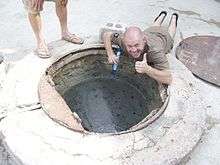LifeStraw

The LifeStraw is a water filter designed to be used by one person to filter water for drinking. It filters a maximum of 1000 litres of water, enough for one person for one year. It removes almost all of waterborne bacteria and parasites.[1] In addition to the classic LifeStraw, the manufacturer also produces other styles on the LifeStraw product: the LifeStraw Family, a larger unit designed for family use, [2] and the LifeStraw Go Water Bottle, which incorporates a LifeStraw filter into a 0.65 litres (22 US fl oz) plastic sports water bottle. [3]
The LifeStraw water filters are designed by the Swiss-based Vestergaard Frandsen. While originally developed for people living in developing nations and for distribution in humanitarian crisis, the LifeStraw has gained popularity as a consumer product. The LifeStraw is now used as a tool for survivalists and packed in emergency preparedness kits in addition to being used to help combat clean water scarcity worldwide. LifeStraw personal filters can provide clean water for up to a year, and the LifeStraw Family filters a maximum of 18,000 litres of water, providing safe drinking water for a family of five for up to three years.
LifeStraw and LifeStraw Family were distributed in the 2010 Haiti earthquake, 2010 Pakistan floods, 2011 Thailand floods, and 2016 Ecuador earthquake, among other crises and initiatives. In the Mutomo District in Kenya which has suffered from long term drought, the Kenya Red Cross supplied filters to 3,750 school children and 6,750 households.[4] In 2015, LifeStraw filters were deployed in Rwanda.[5]
Construction
The LifeStraw is a plastic tube 31 cm long and 3 cm in diameter.[6] Water that is drawn up through the straw first passes through hollow fibres that filter water particles down to 0.2 µm across, using only physical filtration methods and no chemicals. The entire process is powered by suction, similar to using a conventional drinking straw, and filters up to 1000 litres of water.[7] While the initial model of the filter did not remove Giardia lamblia,[8] LifeStraw now removes a minimum of 99.9% of waterborne protozoan parasites including Giardia and Cryptosporidium.[9] Note that the standard LifeStraw is ineffective in filtering viruses, chemicals, salt water, and heavy metals.[10]
Critical response
LifeStraw has been generally praised for its effective and instant method of bacteria and protozoa removal and consumer acceptability.[11]
Although LifeStraw is available for retail sale in the developed world, the majority of LifeStraw are distributed as part of public health campaigns or in response to complex emergencies by NGOs and organizations that give them away for free in the developing world.[12]
LifeStraw has been praised in the international media and won several awards including the 2008 Saatchi & Saatchi Award for World Changing Ideas, the ‘IDEX: 2005’ International Design Award and "Best Invention of 2005" by Time Magazine.[13] The LifeStraw was featured in the Museum of Modern Art in New York.[14]
See also
References
- ↑ LifeStraw Features
- ↑ LifeStraw Family Features
- ↑ LifeStraw Go
- ↑ Muasya, Phillip (July 1, 2011). "Kenya: Lifestraw Water Filters Saving Lives in Mutomo". The Star. Retrieved 17 March 2013.
- ↑ Thiebes, Joseph (2015-02-23). "SWEETLab deploys half million water filters in Rwanda". Portland State Vanguard. Retrieved 2015-04-21.
- ↑ Friend, Gil. "The LifeStraw". Worldchanging - Evaluation + Tools + Best Practices. Retrieved 2015-04-21.
- ↑ Longevity and Efficacy
- ↑ Water for The World, MSNBC, By Jennie Yabroff, 6/12/07.
- ↑ Does LifeStraw remove parasites like cryptosporidium and giardia?, Vestergaard Frandsen
- ↑ Does the LifeStraw filter out heavy metals, chemicals or viruses?
- ↑ Customer Acceptability
- ↑ The force behind LifeStraw
- ↑ Awards
- ↑ Cheshire, Tom (1 March 2010). "Work Smarter: Vestergaard Frandsen". Wired. Retrieved 23 March 2012.
External links
- LifeStraw Website
- Rotary Club of Brynmawr Lifestraw Charity Website
- The Straw that Broke the Bacterium’s Back, Weizmann Institute of Science